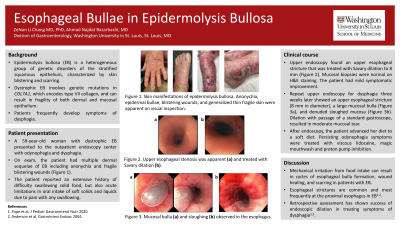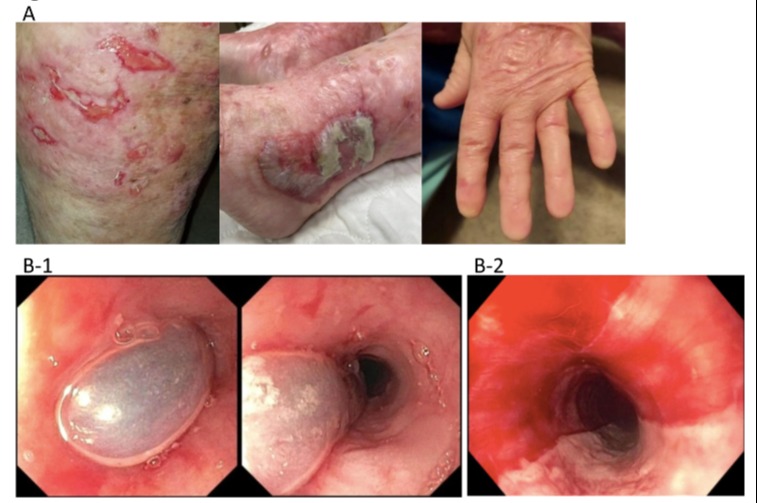Back


Poster Session B - Monday Morning
Category: Esophagus
B0242 - Epidermolysis Bullosa: A Rare Cause of Upper Esophageal Stenosis
Monday, October 24, 2022
10:00 AM – 12:00 PM ET
Location: Crown Ballroom

Has Audio
- ZC
ZeNan Chang, MD, PhD
Barnes Jewish Hospital at Washington University in St. Louis
St. Louis, MO
Presenting Author(s)
ZeNan Chang, MD, PhD1, Ahmad Bazarbashi, MD2
1Barnes Jewish Hospital at Washington University in St. Louis, St. Louis, MO; 2Washington University School of Medicine, St. Louis, MO
Introduction: Epidermolysis bullosa is a rare heterogeneous group of genetic disorders of the stratified squamous epithelium, characterized by skin blistering and scarring. Dystrophic epidermolysis bullosa involves genetic mutations in COL7A1 and can result in fragility of both dermal and mucosal epithelium. Blisters and desquamation may occur spontaneously or from trauma. These patients frequently develop esophageal manifestations of their disease including esophageal blisters, stenosis and bullae formation
Case Description/Methods: We present a case of a 59-year-old woman with dystrophic epidermolysis bullosa with several overt findings of her chronic condition on skin exam [Figure A] who presented with odynophagia and dysphagia. She had prior contrasted CT neck imaging at an Emergency Room with no findings to explain her symptoms and had been started on high dose H2RA therapy. An upper endoscopy for dysphagia found an upper esophageal stricture that was dilated with Savary dilation to 8 mm with mild improvement in symptoms (mucosal biopsies were found to be normal). Repeat upper endoscopy for repeat dilation revealed an upper esophageal stricture, a large mucosal bulla, and denuded sloughed mucosa [Figure B1/2]. The stricture measured 8mm in diameter. Dilation was performed with passage of a standard gastroscope, resulting in moderate mucosal tear and improved diameter of stenosis. The patient could advance her diet to a soft diet and is planned for outpatient follow up. Her odynophagia symptoms persisted however, and was treated with viscous lidocaine, magic mouthwash and proton pump inhibition
Discussion: Our case illustrates the development of esophageal mucosal blistering and upper esophageal stenosis in patients with dystrophic epidermolysis bullosa. This likely stems from mechanical irritation from food intake and results in cycles of wound healing and scarring that eventually lead to stenosis and dysphagia. While strictures may occur anywhere in the esophagus, they are predominantly in the upper esophagus in this patient population and may require dilation. Endoscopists should familiarize themselves with esophageal manifestations of this rare disease and its tendency to cause upper esophageal stenosis

Disclosures:
ZeNan Chang, MD, PhD1, Ahmad Bazarbashi, MD2. B0242 - Epidermolysis Bullosa: A Rare Cause of Upper Esophageal Stenosis, ACG 2022 Annual Scientific Meeting Abstracts. Charlotte, NC: American College of Gastroenterology.
1Barnes Jewish Hospital at Washington University in St. Louis, St. Louis, MO; 2Washington University School of Medicine, St. Louis, MO
Introduction: Epidermolysis bullosa is a rare heterogeneous group of genetic disorders of the stratified squamous epithelium, characterized by skin blistering and scarring. Dystrophic epidermolysis bullosa involves genetic mutations in COL7A1 and can result in fragility of both dermal and mucosal epithelium. Blisters and desquamation may occur spontaneously or from trauma. These patients frequently develop esophageal manifestations of their disease including esophageal blisters, stenosis and bullae formation
Case Description/Methods: We present a case of a 59-year-old woman with dystrophic epidermolysis bullosa with several overt findings of her chronic condition on skin exam [Figure A] who presented with odynophagia and dysphagia. She had prior contrasted CT neck imaging at an Emergency Room with no findings to explain her symptoms and had been started on high dose H2RA therapy. An upper endoscopy for dysphagia found an upper esophageal stricture that was dilated with Savary dilation to 8 mm with mild improvement in symptoms (mucosal biopsies were found to be normal). Repeat upper endoscopy for repeat dilation revealed an upper esophageal stricture, a large mucosal bulla, and denuded sloughed mucosa [Figure B1/2]. The stricture measured 8mm in diameter. Dilation was performed with passage of a standard gastroscope, resulting in moderate mucosal tear and improved diameter of stenosis. The patient could advance her diet to a soft diet and is planned for outpatient follow up. Her odynophagia symptoms persisted however, and was treated with viscous lidocaine, magic mouthwash and proton pump inhibition
Discussion: Our case illustrates the development of esophageal mucosal blistering and upper esophageal stenosis in patients with dystrophic epidermolysis bullosa. This likely stems from mechanical irritation from food intake and results in cycles of wound healing and scarring that eventually lead to stenosis and dysphagia. While strictures may occur anywhere in the esophagus, they are predominantly in the upper esophagus in this patient population and may require dilation. Endoscopists should familiarize themselves with esophageal manifestations of this rare disease and its tendency to cause upper esophageal stenosis

Figure: Figure A: Chronic skin changes of dystrophic epidermolysis bullosa
Figure B1: Esophageal bullae and blistering
Figure B2: Denuded esophageal mucosa
Figure B1: Esophageal bullae and blistering
Figure B2: Denuded esophageal mucosa
Disclosures:
ZeNan Chang indicated no relevant financial relationships.
Ahmad Bazarbashi indicated no relevant financial relationships.
ZeNan Chang, MD, PhD1, Ahmad Bazarbashi, MD2. B0242 - Epidermolysis Bullosa: A Rare Cause of Upper Esophageal Stenosis, ACG 2022 Annual Scientific Meeting Abstracts. Charlotte, NC: American College of Gastroenterology.
